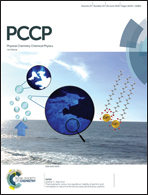Developing effective electronic-only coupled-cluster and Møller–Plesset perturbation theories for the muonic molecules†
Abstract
Recently we have proposed an effective Hartree–Fock (EHF) theory for the electrons of the muonic molecules that is formally equivalent to the HF theory within the context of the nuclear-electronic orbital theory [Phys. Chem. Chem. Phys., 2018, 20, 4466]. In the present report we extend the muon-specific effective electronic structure theory beyond the EHF level by introducing the effective second order Møller–Plesset perturbation theory (EMP2) and the effective coupled-cluster theory at single and double excitation levels (ECCSD) as well as an improved version including perturbative triple excitations (ECCSD(T)). These theories incorporate electron–electron correlation into the effective paradigm and through their computational implementation, a diverse set of small muonic species is considered as a benchmark at these post-EHF levels. A comparative computational study on this set demonstrates that the muonic bond length is in general non-negligibly longer than corresponding hydrogenic analogs. Next, the developed post-EHF theories are applied for the muoniated N-heterocyclic carbene/silylene/germylene and the muoniated triazolium cation revealing the relative stability of the sticking sites of the muon in each species. The computational results, in line with previously reported experimental data demonstrate that the muon generally prefers to attach to the divalent atom with carbeneic nature. A detailed comparison of these muonic adducts with the corresponding hydrogenic adducts reveals subtle differences that have already been overlooked.



 Please wait while we load your content...
Please wait while we load your content...